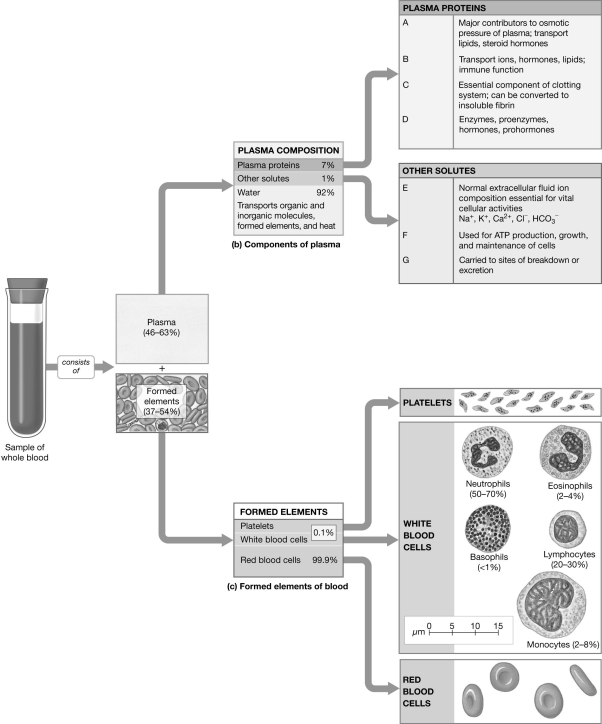Correct Answer

verified
Correct Answer
verified
Multiple Choice
Having too many red blood cells is called
A) erythrocytosis.
B) erythropenia.
C) hemocytosis.
D) erythropoiesis.
E) hematopenia.
Correct Answer

verified
Correct Answer
verified
Multiple Choice
Neutrophils
A) are granular leukocytes.
B) are phagocytic.
C) have lobed nuclei.
D) are active in fighting bacterial infection.
E) all of the above
Correct Answer

verified
Correct Answer
verified
Short Answer
Blood is approximately _________________________ percent plasma by volume.
Correct Answer

verified
Correct Answer
verified
Multiple Choice
The inherited condition resulting from the inadequate production of clotting factors is termed
A) anemia.
B) thalassemia.
C) jaundice.
D) hemophilia.
E) none of the above
Correct Answer

verified
Correct Answer
verified
Multiple Choice
Platelets are
A) cells.
B) proteins.
C) cell fragments.
D) nuclei.
E) antibodies.
Correct Answer

verified
Correct Answer
verified
Multiple Choice
The least numerous white blood cells in peripheral circulation are the
A) neutrophils.
B) eosinophils.
C) basophils.
D) lymphocytes.
E) monocytes.
Correct Answer

verified
Correct Answer
verified
Multiple Choice
Which of the following vitamins is needed for the formation of clotting factors?
A) vitamin A
B) vitamin B
C) vitamin C
D) vitamin K
E) vitamin E
Correct Answer

verified
Correct Answer
verified
Multiple Choice
Platelets release ________, which causes local vasoconstriction.
A) serotonin
B) epinephrine
C) collagen
D) prostaglandin
E) fibrin
Correct Answer

verified
Correct Answer
verified
Multiple Choice
This disease is characterized by an incorrect production of hemoglobin proteins.
A) sickle cell anemia
B) thalassemia
C) hematuria
D) jaundice
E) aplastic anemia
Correct Answer

verified
Correct Answer
verified
Short Answer
 -Label E: ________
-Label E: ________
Correct Answer

verified
Correct Answer
verified
Multiple Choice
Biconcave cells without a nucleus are called
A) lymphocytes.
B) neutrophils.
C) eosinophils.
D) erythrocytes.
E) monocytes.
Correct Answer

verified
Correct Answer
verified
Multiple Choice
A toxin that blocks the stomach's ability to release intrinsic factor would cause
A) asphyxiation.
B) acidosis.
C) hemorrhage.
D) leukemia.
E) anemia.
Correct Answer

verified
Correct Answer
verified
Multiple Choice
The function of white blood cells is to
A) remove carbon dioxide from active cells.
B) remove nitrogenous wastes from active tissues.
C) carry oxygen from the lungs to the body's cells.
D) carry nutrients from the digestive system to the body's cells.
E) defend the body against infectious organisms.
Correct Answer

verified
Correct Answer
verified
Multiple Choice
Pus contains
A) leukocytes.
B) bacteria.
C) damaged body cells.
D) platelets.
E) all of the above
Correct Answer

verified
Correct Answer
verified
Multiple Choice
A stationary blood clot is called a(n)
A) embolus.
B) thrombus.
C) plaque.
D) coagulant.
E) platelet plug.
Correct Answer

verified
Correct Answer
verified
Multiple Choice
How would an increase in the concentration of calcium ion in the blood affect the process of hemostasis?
A) Platelet plugs would fail to form.
B) Coagulation would proceed more rapidly.
C) Coagulation would proceed more slowly.
D) Retraction would occur prematurely.
E) Fibrinolysis would occur more quickly.
Correct Answer

verified
Correct Answer
verified
Multiple Choice
The average life span of a red blood cell is
A) 1 week.
B) 1 month.
C) 4 months.
D) 6 months.
E) 1 year.
Correct Answer

verified
Correct Answer
verified
Multiple Choice
The percentage of solids in a sample of human blood is normally about
A) 45 percent.
B) 10 percent.
C) 25 percent.
D) 70 percent.
E) 90 percent.
Correct Answer

verified
Correct Answer
verified
Multiple Choice
Each heme group in a molecule of hemoglobin contains ________ atom(s) of iron.
A) 1
B) 2
C) 3
D) 4
E) 1/2
Correct Answer

verified
Correct Answer
verified
Showing 21 - 40 of 80
Related Exams